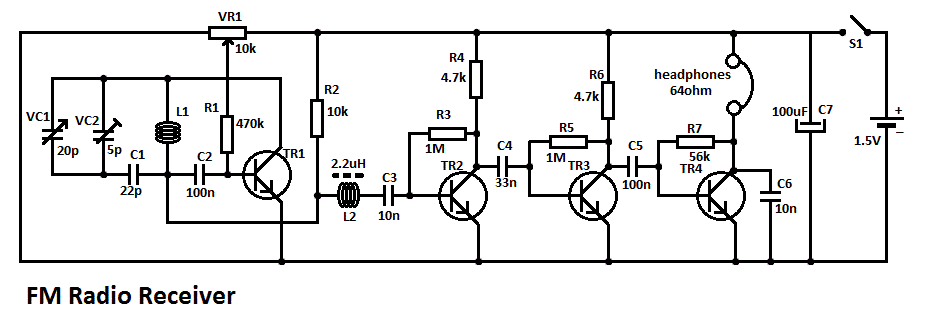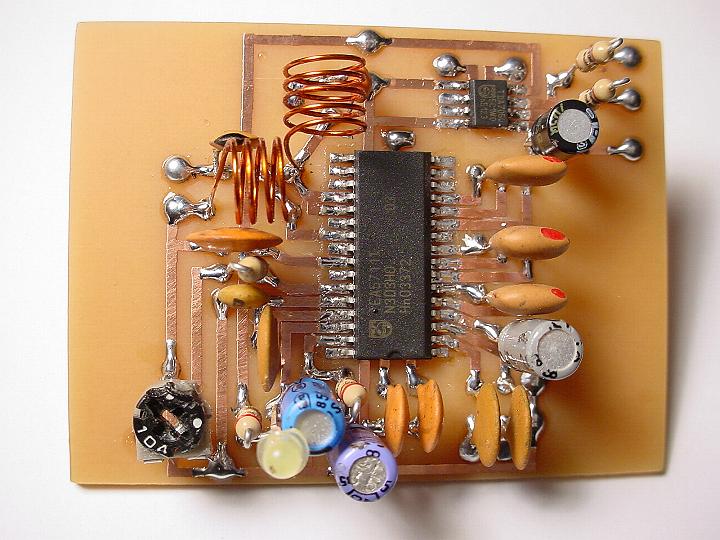|
|
FM / AM Regenerative Receiver
The following is a design for a separately quench super regen receiver I first tried in early 1992. It worked far better than any other solid state design, so I built a portable version for use during my commuting from the Blue Mountains to Sydney on the train. Running off 10x AA nicads, this gave me a weeks listening before recharging. Only recently, I submitted the basic circuit to Silicon Chip, whereupon it was published in the April 2003 issue (and I won a nice true RMS meter as a result). My portable version differs in that I use varicap tuning, the output transformer has a 1K primary, and the output transistor is a BC108, with bias components to suit. It also uses the headphone lead for the aerial.

FM Broadcast Receiver
Here's a portable FM broadcast radio receiver for reception of FM broadcast band based around FET transistor. The topology is a classic grounded-gate FET VHF Hartley oscillator. The drain resonator inductance is centre-tapped with feedback to the source through a small capacitance. By tapping down towards the cold-end of the coil the feedback isn't as critical as your usual source-drain capacitor feedback and it tends to be far less difficult to get to work across a broad range of frequencies. The RFC to an RC source circuit to implement self-quenching is very traditional for super-regenerative detectors. The quench gets frequency-modulated somewhat by the drain current, so it varies with signal strength and the recovered modulation, this is typical for self-quenched circuits.

FM Radio Receiver
This simple fm radio receiver circuit consists of a regenerative rf stage, TR1, followed by a two of three-stage audio amplifier, TR2 to TR4. In some areas 3 stages of audio amplification may not be necessary, in which case TR3 and its associated components can be omitted and the free end of capacitor C5 connected to the collector of TR2.

FM Radio Receiver
This simple fm radio receiver circuit consists of a regenerative rf stage, TR1, followed by a two of three-stage audio amplifier, TR2 to TR4. In some areas 3 stages of audio amplification may not be necessary, in which case TR3 and its associated components can be omitted and the free end of capacitor C5 connected to the collector of TR2.

FM Radio Receiver using TDA7088
This tiny receiver is not much bigger than an AA cell. It is powered off two LR44 button cells, which are expensive and I assume wouldn't last terribly long. I'll be on the lookout for LR44's at the markets and $2 shops now that I've got this radio! As with all these sorts of radios, the headphone lead functions as the aerial. Supplied with this receiver were a pair of those awful "in-the-ear" type of miniature type earphones. Apart from the appalling sound quality, they are insensitive, unhygenic and dirty, fragile, and do not block out external sounds. So, I use the normal kind of headphones instead.
The enclosure is all clipped together, and once I'd opened it, sure enough, a TDA7088T was visible.
The audio amp appears to be one transistor; ie. single ended class A. I don't know what current it's drawing so I can't say whether it's consuming much more battery current than a class B amp would. In any case I would prefer AAA cells rather than the LR44's.

FM Radio with TDA7000
This project is a FM Radio based on TDA7000 and LM386 integrated circuits. What is unusual about TDA7000 IC is how it operates. It is a proper FM superhet receiver, with the usual local oscillator, mixer, IF amplifier, limiter, and phase detector. The difference is that there's only one tuned circuit; the local oscillator. Like the Pulse Counting Receiver, the TDA7000 relies on a low IF so that ordinary Op Amp circuitry can take care of the gain and bandpass characteristics. Only 70Kc/s is used with the TDA7000. Now, you might remember that the deviation of a broadcast FM signal is +/- 75Kc/s. A fully modulated signal would therefore sound rather distorted. So, how can this IC work?
It's quite simple in that there is what Philips call a Frequency Locked Loop. Basically, the local oscillator is shifted in response to detector output so that the bandwidth of the mixer output is never more than +/- 15Kc/s. It is actually compressing the frequency range of the modulated signal.
The muting or squelch feature is novel to say the least. Although it performs as any other muting circuit does, the TDA7000 provides an artificial noise generator so that the receiver still sounds alive while tuned off station. If you don't need that feature, just remove the .022uF condenser at pin 3. Not all Philips data sheets show it, but connecting a 10K resistor from the supply to pin 1 will disable the squelch.

FM Receivers
Here is how you make a superregenerative circuit. Choose a regenerative amplifier circuit configuration that requires more current during oscillations than when not oscillating. Adjust the regenerative amplifier to oscillate. Add a small circuit that uses the current of the amplifier to charge a capacitor while oscillations are taking place. Once the capacitor is charged, the voltage on the capacitor is used to kill the oscillations of the circuit. (Technically, the capacitor voltage shifts the operating point of the amplifier to reduce its gain and stop the oscillations.) When the oscillations stop, the capacitor discharges (through a resistor). Once the capacitor is discharged, the oscillations begin again.

FM Stereo Receiver
The receiver is built around TEA5711 and TDA7050 ICs. The receiver section of the TEA5711 features high selectivity with distributed IF gain, good strong signal handling, AFC (automatic frequency control) for drift-free reception, a mute circuit to decrease static on weak stations, and an MPX decoder for stereo reception. The TDA7050 features low distortion and is rated at 75 mW output per channel. The application circuit uses 3 volts to power the receiver, but I decided to run my receiver with 4.5 volts for increased audio output.

LA1800 FM Radio
3V superheterodyne FM receiver

One Transistor FM Receiver
This radio is sensitive enough to tune 20 stations across the FM band, some with volume high enough to drive a small PM speaker. The ability to tune 88.9 MHz and 89.1 MHz is testimony of its selectivity. The signal-to noise ratio rivals that of the better walkman type radios.

|
|
|
| |
Accurate LC Meter
Build your own Accurate LC Meter (Capacitance Inductance Meter) and start making your own coils and inductors. This LC Meter allows to measure incredibly small inductances making it perfect tool for making all types of RF coils and inductors. LC Meter can measure inductances starting from 10nH - 1000nH, 1uH - 1000uH, 1mH - 100mH and capacitances from 0.1pF up to 900nF. The circuit includes an auto ranging as well as reset switch and produces very accurate and stable readings. |
|
PIC Volt Ampere Meter
Volt Ampere Meter measures voltage of 0-70V or 0-500V with 100mV resolution and current consumption 0-10A or more with 10mA resolution. The meter is a perfect addition to any power supply, battery chargers and other electronic projects where voltage and current must be monitored. The meter uses PIC16F876A microcontroller with 16x2 backlighted LCD. |
|
|
|
60MHz Frequency Meter / Counter
Frequency Meter / Counter measures frequency from 10Hz to 60MHz with 10Hz resolution. It is a very useful bench test equipment for testing and finding out the frequency of various devices with unknown frequency such as oscillators, radio receivers, transmitters, function generators, crystals, etc. |
|
1Hz - 2MHz XR2206 Function Generator
1Hz - 2MHz XR2206 Function Generator produces high quality sine, square and triangle waveforms of high-stability and accuracy. The output waveforms can be both amplitude and frequency modulated. Output of 1Hz - 2MHz XR2206 Function Generator can be connected directly to 60MHz Counter for setting precise frequency output. |
|
|
|
BA1404 HI-FI Stereo FM Transmitter
Be "On Air" with your own radio station! BA1404 HI-FI Stereo FM Transmitter broadcasts high quality stereo signal in 88MHz - 108MHz FM band. It can be connected to any type of stereo audio source such as iPod, Computer, Laptop, CD Player, Walkman, Television, Satellite Receiver, Tape Deck or other stereo system to transmit stereo sound with excellent clarity throughout your home, office, yard or camp ground. |
|
USB IO Board
USB IO Board is a tiny spectacular little development board / parallel port replacement featuring PIC18F2455/PIC18F2550 microcontroller. USB IO Board is compatible with Windows / Mac OSX / Linux computers. When attached to Windows IO board will show up as RS232 COM port. You can control 16 individual microcontroller I/O pins by sending simple serial commands. USB IO Board is self-powered by USB port and can provide up to 500mA for electronic projects. USB IO Board is breadboard compatible. |
|
|
|
|
ESR Meter / Capacitance / Inductance / Transistor Tester Kit
ESR Meter kit is an amazing multimeter that measures ESR values, capacitance (100pF - 20,000uF), inductance, resistance (0.1 Ohm - 20 MOhm), tests many different types of transistors such as NPN, PNP, FETs, MOSFETs, Thyristors, SCRs, Triacs and many types of diodes. It also analyzes transistor's characteristics such as voltage and gain. It is an irreplaceable tool for troubleshooting and repairing electronic equipment by determining performance and health of electrolytic capacitors. Unlike other ESR Meters that only measure ESR value this one measures capacitor's ESR value as well as its capacitance all at the same time. |
|
Audiophile Headphone Amplifier Kit
Audiophile headphone amplifier kit includes high quality audio grade components such as Burr Brown OPA2134 opamp, ALPS volume control potentiometer, Ti TLE2426 rail splitter, Ultra-Low ESR 220uF/25V Panasonic FM filtering capacitors, High quality WIMA input and decoupling capacitors and Vishay Dale resistors. 8-DIP machined IC socket allows to swap OPA2134 with many other dual opamp chips such as OPA2132, OPA2227, OPA2228, dual OPA132, OPA627, etc. Headphone amplifier is small enough to fit in Altoids tin box, and thanks to low power consumption may be supplied from a single 9V battery. |
|
|
|
|
|
Arduino Prototype Kit
Arduino Prototype is a spectacular development board fully compatible with Arduino Pro. It's breadboard compatible so it can be plugged into a breadboard for quick prototyping, and it has VCC & GND power pins available on both sides of PCB. It's small, power efficient, yet customizable through onboard 2 x 7 perfboard that can be used for connecting various sensors and connectors. Arduino Prototype uses all standard through-hole components for easy construction, two of which are hidden underneath IC socket. Board features 28-PIN DIP IC socket, user replaceable ATmega328 microcontroller flashed with Arduino bootloader, 16MHz crystal resonator and a reset switch. It has 14 digital input/output pins (0-13) of which 6 can be used as PWM outputs and 6 analog inputs (A0-A5). Arduino sketches are uploaded through any USB-Serial adapter connected to 6-PIN ICSP female header. Board is supplied by 2-5V voltage and may be powered by a battery such as Lithium Ion cell, two AA cells, external power supply or USB power adapter. |
|
200m 4-Channel 433MHz Wireless RF Remote Control
Having the ability to control various appliances inside or outside of your house wirelessly is a huge convenience, and can make your life much easier and fun. RF remote control provides long range of up to 200m / 650ft and can find many uses for controlling different devices, and it works even through the walls. You can control lights, fans, AC system, computer, printer, amplifier, robots, garage door, security systems, motor-driven curtains, motorized window blinds, door locks, sprinklers, motorized projection screens and anything else you can think of. |
|
|
|
|